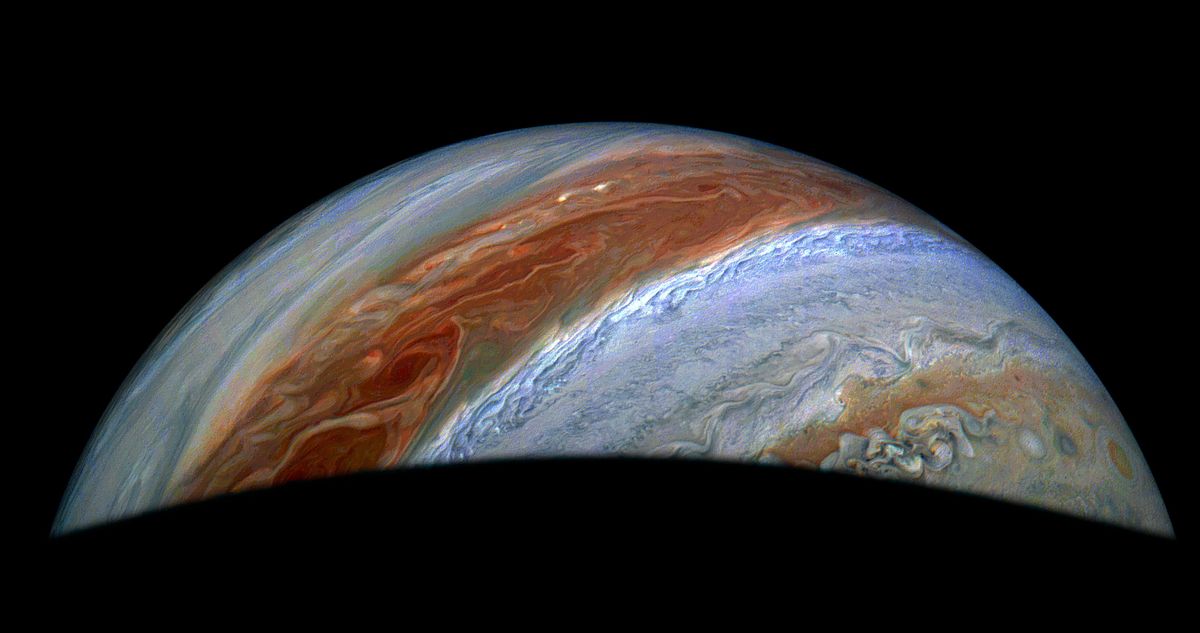Science
Related: About this forumNew data from NASA's Juno mission shows winds beneath Jupiter and Io surfaces
May 1, 2025
By Evrim Yazgin
NASA’s Juno mission has peered below the surface to help scientists better understand Jupiter’s storms and its moon Io’s subsurface temperature.

Jupiter seen over moon silhouette
Jupiter, as seen by NASA’s Juno spacecraft on Dec. 28, 2024. Credit: NASA / SwRI / MSSS / Jackie Branc (CC BY).
Juno was launched in 2011 and has been in orbit around Jupiter since 2016. Its mission has been extended a beyond its original 5 years. It is now due to finish in September this year, or until the end of the spacecraft’s life.
NASA has provided an update of the latest findings from Juno.
The mission team used the spacecraft’s microwave radiometer (MWR) to look at Io – one of Jupiter’s 4 largest moons, together known as the Galilean satellites because they were first observed by Galileo Galilei in 1610.
The MWR instrument was originally designed to peer beneath Jupiter’s clouds.
“The Juno science team loves to combine very different datasets from very different instruments and see what we can learn,” says Juno scientist Shannon Brown, from NASA’s Jet Propulsion Laboratory in Southern California.
“When we incorporated the MWR data with JIRAM’s infrared imagery, we were surprised by what we saw: evidence of still-warm magma that hasn’t yet solidified below Io’s cooled crust. At every latitude and longitude, there were cooling lava flows,” Brown says.
More:
https://cosmosmagazine.com/space/astronomy/nasa-juno-jupiter-io-surface/
Judi Lynn
(163,703 posts)By Keith Cooper
published April 30, 2025
A group of swirling storms at Jupiter's north pole are bouncing off each other, like bumper cars at the fairground.
. . .
A flurry of new discoveries from NASA's Juno mission Jupiter have taken us beneath the surface of the gas giant's volcanic moon, Io, and into the world of cyclones playing bumper cars at the north Jovian pole.
Juno arrived at the Jupiter system in 2016, but a failed thruster meant that it is now stuck in a wide, polar orbit that brings it close to Jupiter and its moons every 53 days. Still, during those flybys, Juno has amassed a bevy of high-quality data about Jupiter's atmosphere, including at the planet's poles, which had not previously been studied in detail.
At Jupiter's north pole is a cap of stratospheric haze, which Juno has measured to be cooler than its surroundings by 52 degrees Fahrenheit (11 degrees Celsius). Around the polar cap are jet streams blowing faster than 100 miles per hour (161 kilometers per hour). Below the haze, the north polar region is inhabited by one giant, central cyclone about 1,864 miles (3,000 kilometers) across, surrounded by its "groupies" — eight smaller cyclones between 1,490 and 1,790 miles (2,400 and 2,800 kilometers) in size, far surpassing any similar phenomena we have on Earth.
Juno has been tracking the motion of this system of cyclones in visible and infrared light (in the guise of heat coming from deeper within the atmosphere) since 2016, using its JunoCam and Jovian Infrared Aurora Mapper (JIRAM), respectively. These two instruments have shown that each of the eight cyclones drift towards the pole via a process called "beta drift." The same process occurs to cyclones on Earth, and is the result of the Coriolis force interacting with the whirling wind pattern belonging to each cyclone. However, on Earth, cyclones never get anywhere near the poles. That's because the closer they get to cold, dry poles, the more they run out of the warm, moist air that gives them energy. On Jupiter, the atmospheric dynamics are different, and this is not a problem. But once at the pole, Jupiter's cyclones start bumping into each other.
More:
https://www.space.com/astronomy/jupiter/cyclones-on-jupiter-and-a-moon-with-flowing-magma-nasa-juno-probes-latest-discoveries-are-awesome